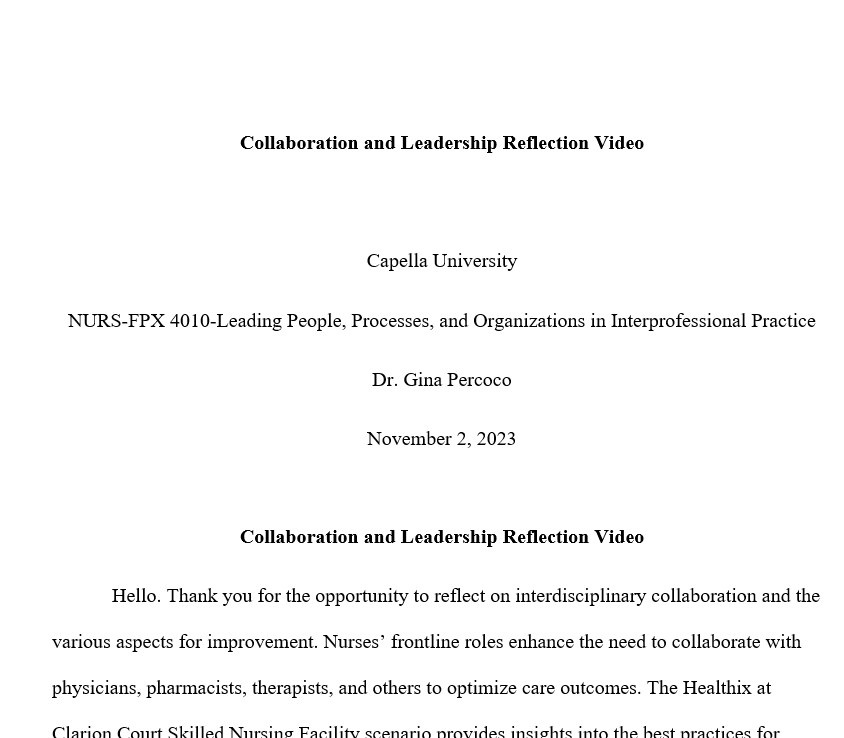Interdisciplinary Plan Proposal
Capella University
NURS-FPX4010 Leading People, Processes, and Organizations in Interprofessional Practice
Professor Graebe
October 2, 2024
Interdisciplinary Plan Proposal
This issue that this proposal plans to address is short staffing among registered nurses. The part of the hospital in which the plan will be conducted is on each inpatient floor. The desired outcome of implementing this proposal is for the stressful environment due to short staffing on inpatient floors to be alleviated and as a result improve collaboration and patient outcomes.
Objective
Every inpatient floor in the hospital is experiencing inadequate staffing of registered nurses daily and in turn causing high nurse to patient ratios. The proposal will give nurses support by considering hiring support staff through a range of factors and improving interdisciplinary communication which will have positive results on its own. By addressing this issue, the strained conditions these nurses face will ease and the negative outcomes of working in a high nurse to patient ratio, such as decreased patient satisfaction, will reverse. Additionally, as these changes become more permanent, there should be an increase in perspective staff members. Finally, with permanent staff as a solution, organizational costs should decrease with the decrease of high-cost temporary positions.
Questions and Predictions
- How will this plan effect the daily responsibilities of the floor staff?
The registered nurses should mostly see a decrease in overall responsibilities as the support is geared towards helping reduce tasks due to short staffing. There may be a very slight decrease in time to complete tasks, as rounding and interdisciplinary communication should increase. Still, the two should balance each other out.
- How long will it take to implement the proposal?
The plan should take 3-6 months to implement. This allows for time to recruit/hire support staff, train this new staff, and implement changes in how interdisciplinary teams communicate. Furthermore, this allows the organization time to reallocate funds to facilitate the plan and move from high-cost positions.
- How will this plan effect the interdisciplinary teams aside from the nurses?
Other disciplines, as well as nursing staff, will need to set aside time to implement rounding to coordinate plans of care. According to Sigmon, one of the challenges of working in an interdisciplinary healthcare team is creating a process that does not only add to the nurse’s responsibilities (2020). Within this rounding, teams should be able to coordinate timing, so each is not affecting the others’ ability to conduct their necessary care.
Change Theories and Leadership Strategies
To implement the change proposed to resolve the stress of short staffing on inpatient units, a democratic leadership style coupled with Lewin’s change model has the potential to produce probable results. Through democratic leadership, management can tailor change implementation to best meet the teams needs based on the inclusion of their opinions and ideas (Crosby, 2020). Even though all stakeholders are able to put forth their ideas, it is ultimately the leader’s final decision. For this reason, not being able to appease everyone, Lewin’s change model is a best option. Lewin’s change model has three stages: unfreezing, movement, and refreezing.
For this proposal, the democratic leadership and the stage of unfreezing are important to work together. The democratic leader will begin the unfreezing phase by meeting with stakeholders and educating them on the issue. Furthermore, this is the opportunity to gather the common ideas and opinions on how to change the units to alleviate short staffing. This stage is also important because it is a fantastic opportunity to convince stakeholders to buy in. By feeling heard and knowing that change is attempting to be made, makes the proposal attractive.
The second stage in Lewin’s change model is movement. For example, in this proposal, the change would begin by implementing the new hire strategies and new collaboration requirements. The buy in for this stage would come through staff feeling the shift from high stress and lower patient outcomes to high morale and patient satisfaction. Lastly is the refreezing stage. To address the short staffing for this stage, leadership should continue a democratic style through continued listening to stakeholders to see what is working and not working to maintain the new order. Overall, this organization would be likely to implement this proposal due to short staffing influencing an array of factors within. Lowering costs, improving patient satisfaction rates, and increasing morale among staff are just a few.
Team Collaboration Strategies
Leader: Senior manager/Floor manager will plan team meeting to educate and collect data on the issue and plan improvements. They are the representative for presenting the information to superiors and advocating for the change to happen. Coordinating collaboration and creating a system for implementation without causing chaos will be a responsibility as well. This includes things like scheduling rounding times that work best for the entire team and hiring and establishing appropriate schedules. For example, “Each shift’s huddle should occur at a designated time every day and be led by the most senior nurse or provider (Sigmon, 2020, para. 3).”
Human Resources: Obtain applicants and facilitate hiring processes
Executive positions/Hopsital managers: Will monitor the allocation of funds and evaluate effectiveness of proposed plan. This will affect the team and is relevant because it will be a driving force in allowing for the extra resources. These resources are external and structural and whenever bringing in and changing something as such, the decision is left to those in top positions (Schot, et al., 2020).
Healthcare Professionals (Physicians, nurses, etc.): Must collaborate effectively to make the change an asset to all team members while focusing on improving the environment for staff and patients alike. Aside from rounding, interdisciplinary teams can work together to alleviate short staffing through things like daily goals worksheets and shared training (Sigmon, 2020). For example, when hiring support staff, nurses can train a small group to be the best support for the floor. After that initial training, further interdisciplinary training can occur where appropriate.
Required Organizational Resources
The organizational resources required for this proposal may seem vast at first, but when considering what is taken away while implementing the change, many of the resources are already in place. Other than the shift of funds, the most crucial resource required is time and collaboration. The organization currently has an influx of travel nurses, which are one of the highest costing staff. Overtime the implementation of this plan could reduce that cost. Initially, there would be a need for anywhere from $500-$5000 per new staff member as incentive for hire and retention. Managers will need to spend time creating ways to attract this new staff, plans to incorporate them into training, and plan interdisciplinary rounding situations.
Alleviating short staffing among registered nurses through the hiring of support staff and improvement of interdisciplinary collaboration is vital to the organization to maintain a healthy environment dedicated to positive patient outcomes, to eventually decrease costs, and to overall find a balance of resources and quality (Cipriano, 2021). Likewise, if short staffing continues patient safety and quality will suffer and costs will continue to increase for the organization.
References
Cipriano, P. (2021). CNO-CFO collaboration for safe nurse staffing: Steps for building a partnership. American nurse today, 16(2).
Crosby, G. (2020). Lewin’s democratic style of situational leadership: A fresh look at a powerful od model. The Journal of Applied Behavioral Science, 002188632097981. https://doi.org/10.1177/0021886320979810
Schot, E., Tummers, L., & Noordegraaf, M. (2019). Working on working together. a systematic review on how healthcare professionals contribute to interprofessional collaboration. Journal of Interprofessional Care, 34(3), 332–342. https://doi.org/10.1080/13561820.2019.1636007
Sigmon, L. B. (2020). Interprofessional collaboration made easy: Strategies for improving results. American nurse today, 15(11).

